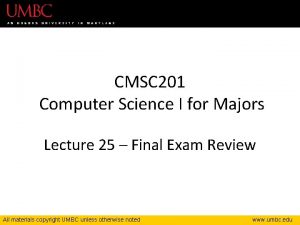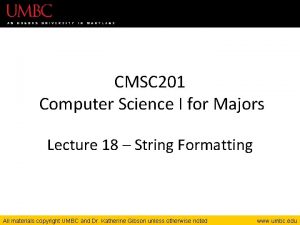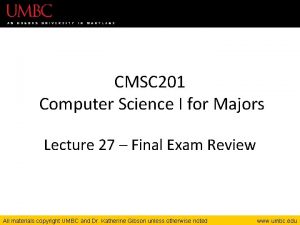CMSC 201 Computer Science I for Majors Lecture








































![Nested Loop Example • What does this code do? scores = [] for i Nested Loop Example • What does this code do? scores = [] for i](https://slidetodoc.com/presentation_image_h/23b2775323b7800720efb9618fe51a2c/image-41.jpg)










![Answers: Two-Dimensional Lists 1. for i in ex_nums[0]: print(i) 2. ex_nums[0][3] = "four" 3. Answers: Two-Dimensional Lists 1. for i in ex_nums[0]: print(i) 2. ex_nums[0][3] = "four" 3.](https://slidetodoc.com/presentation_image_h/23b2775323b7800720efb9618fe51a2c/image-52.jpg)


- Slides: 54

CMSC 201 Computer Science I for Majors Lecture 09 – While Loops Prof. Katherine Gibson www. umbc. edu

Last Class We Covered • Using for loops – Syntax – Using it to iterate over a list – Using it for “counting” the number of actions • The range() function – Syntax – Three forms: one, two, or three numbers 2 www. umbc. edu

Any Questions from Last Time? www. umbc. edu

Today’s Objectives • To learn about and use a while loop – To understand the syntax of a while loop – To use a while loop for interactive loops • To learn two different ways to mutate a list – append() and remove() • To apply our knowledge to created nested loops • To touch (briefly) on two-dimensional lists 4 www. umbc. edu

Review: Looping www. umbc. edu

Remember our Average for Loop? • Use a for loop to find the average from a list of numbers nums = [98, 75, 89, 100, 45, 82] total = 0 # we have to initialize total to zero for n in nums: total = total + n # so that we can use it here avg = total / len(nums) print("Your average in the class is: ", avg) 6 www. umbc. edu

Getting Flexible Input • What if we only want positive numbers? • And we want to re-prompt the user if they enter a negative number? – And keep re-prompting until they enter a positive • We can’t do this with a for loop – why? – They only run a pre-set number of times – We don’t know how many times to re-prompt 7 www. umbc. edu

Looping • Python has two kinds of loops, and they are used for two different purposes • The for loop: – Good for iterating over a list – Good for counted iterations • The while loop what we’re covering today – Good for almost everything else 8 www. umbc. edu

while Loops: Syntax and Uses www. umbc. edu

The while Loop • The while loop is used when we’re not – Iterating over a list – Doing a “counted” loop • Works the way its name implies: While a certain condition is not yet met: Continue to repeatedly do a thing 10 www. umbc. edu

Parts of a while Loop • Here’s some example code… let’s break it down date = 0 while date < 1 or date > 31: date = int(input("Enter the day: ")) print("Today is September", date) 11 www. umbc. edu

Parts of a while Loop • Here’s some example code… let’s break it down initialize the variable the while loop will use for its decision date = 0 the loop’s Boolean condition (loop runs until this is False) while date < 1 or date > 31: date = int(input("Enter the day: ")) the body of the loop print("Today is September", (must date) change the value of the loop variable) 12 www. umbc. edu

How a while Loop Works • The while loop requires a Boolean condition – That it then evaluates to either True or False • If the condition is True: – Body of while loop is executed • If the condition is False: – Body of while loop is skipped 13 www. umbc. edu

Example while Loop • We can use a while loop to do a “counting” loop, just like we used a for loop num = 1 # we have to initialize num to one while num <= 20: print(num) num = num + 1 14 # so that we can use it here # change the loop variable www. umbc. edu

Example while Loop Start e l i wh num = 1 num <= 20 TRUE FALSE 15 Display num = num + 1 End www. umbc. edu

Infinite Loops and Other Problems www. umbc. edu

Infinite Loops • An infinite loop is a loop that will run forever • Can we have an infinite loop using for? – No! – the for loop goes through a set number of steps (iterating or counting) and will always end • Can we have an infinite loop using while? – Yes! – the while loop’s loop variable is controlled by us, and we can make mistakes 17 www. umbc. edu

Infinite Loop Example #1 • Why doesn’t this loop end? What will fix it? age = 0 while age < 18: # can’t vote until 18 print("You can’t vote at age", age) print("Now you can vote! Yay!") 18 www. umbc. edu

Infinite Loop Example #1 • Why doesn’t this loop end? What will fix it? the loop variable (age) never changes, so the condition will age = 0 never evaluate to False while age < 18: # can’t vote until 18 print("You can’t vote at age", age) print("Now you can vote! Yay!") 19 www. umbc. edu

Infinite Loop Example #2 • Why doesn’t this loop end? What will fix it? while True: # ask user for name = input("What is your name? ") print("Hello", name + "!") 20 www. umbc. edu

Infinite Loop Example #2 • Why doesn’t this loop end? What will fix it? True will never evaluate to False, so the loop will never exit while True: # ask user for name = input("What is your name? ") print("Hello", name + "!") 21 www. umbc. edu

Infinite Loop Example #3 • Why doesn’t this loop end? What will fix it? cookies. Left = 50 while cookies. Left > 0: # eat a cookies. Left = cookies. Left + 1 print("No more cookies!") 22 www. umbc. edu

Infinite Loop Example #3 • Why doesn’t this loop end? What will fix it? cookies. Left = 50 the loop body is INCREASING while cookies. Left > 0: the number of cookies, so we’ll never reach zero! # eat a cookies. Left = cookies. Left + 1 print("No more cookies!") 23 www. umbc. edu

Loop Body Isn’t Being Run • Unlike most for loops, a while loop’s body may be skipped over entirely – If the Boolean condition is initially False military. Time = 1300 while (military. Time < 1200): print("Good morning!") military. Time = military. Time + 100 24 www. umbc. edu

Updating and Changing Lists www. umbc. edu

Mutating Lists • Remember that lists are defined as “mutable sequences of arbitrary objects” – “Mutable” just means we can change them • So far, the only thing we’ve been able to change about our lists are their contents – But we can also change their size, by adding and removing elements 26 www. umbc. edu

Two List Functions • There are two functions we’ll cover today that can add and remove things to our lists – There are more, but we’ll cover them later append() remove() 27 www. umbc. edu

List Function: append() • The append() function lets us add items to the end of a list, increasing its size LISTNAME. append(ITEM_TO_APPEND) • Useful for creating a list from flexible input – Allows the list to expand as the user needs – No longer need to initialize lists to [None]*NUM 28 www. umbc. edu

Example of append() • We can use append() to create a list of numbers (continuing until the user enters 0) values = [] user. Val = 1 # initialize the list to be empty # give our loop variable a value while user. Val != 0: user. Val = int(input("Enter a number, 0 to stop")) if user. Val != 0: # only append if it's valid values. append(user. Val) # add value to the list 29 www. umbc. edu

Example of append() • We can use append() to create a list of numbers (continuing until the user enters 0) while user. Val != 0: user. Val = int(input("Enter a number, 0 to stop")) if user. Val != 0: # only append if it's valid values. append(user. Val) # add value to the list values = 17 22 0 30 1 5 2 -6 13 3 4 www. umbc. edu

List Function: remove() • The remove() function lets us remove an item from the list – specifically, it finds and removes the first instance of a given value LISTNAME. remove(ITEM_TO_REMOVE) • Useful for deleting things that no longer matter – For example, removing students who have dropped the class from the class roster – Keeps the list from having empty elements 31 www. umbc. edu

Example of remove() • We can use remove() to remove students who have dropped the class from the roster = ["Adam", "Alice", "Andy", "Ariel"] roster. remove("Adam") # Adam has dropped the class # Bob is not in roster, so this causes an error roster. remove("Bob") 32 www. umbc. edu

Example of remove() • We can use remove() to remove students who have dropped the class from the roster = ["Adam", "Alice", "Andy", "Ariel"] roster = Adam Alice Andy Ariel 0 33 1 2 3 www. umbc. edu

Example of remove() • We can use remove() to remove students who have dropped the class from the roster = ["Adam", "Alice", "Andy", "Ariel"] roster. remove("Adam") # Adam has dropped the class roster = Adam Alice Andy Ariel 0 34 1 2 3 www. umbc. edu

Example of remove() • We can use remove() to remove students who have dropped the class from the roster = ["Adam", "Alice", "Andy", "Ariel"] roster. remove("Adam") # Adam has dropped the class roster. remove("Bob") # Bob is not in the class roster = Alice Andy Ariel 0 35 1 ERROR 2 www. umbc. edu

Interactive while Loops www. umbc. edu

When to Use while Loops • while loops are very helpful when you: – Want to get input from the user that meets certain specific conditions • Positive number • A non-empty string – Want to keep getting input until some “end” • User inputs a value that means they’re finished • Reached the end of some input (a file, etc. ) 37 www. umbc. edu

Example while Loop • We can use a while loop to get correct input from the user by re-prompting them num = 0 # we have to initialize num to zero while num <= 0: # so that we can use it here num = int(input("Enter a positive number: ")) # the while loop has exited b/c num is positive print("Thank you. The number you chose is: ", num) 38 www. umbc. edu

Nested Loops www. umbc. edu

Nesting • You have already used nested statements – In HW 3, you used nested if/else statements to help you diagnose a patient • We can also nest loops! – First loop is the outer loop – Second loop is the inner loop 40 www. umbc. edu
![Nested Loop Example What does this code do scores for i Nested Loop Example • What does this code do? scores = [] for i](https://slidetodoc.com/presentation_image_h/23b2775323b7800720efb9618fe51a2c/image-41.jpg)
Nested Loop Example • What does this code do? scores = [] for i in range(10): num = 0 while num <= 0: num = int(input("Enter a positive #: ")) scores. append(num) print(scores) 41 www. umbc. edu

Nested Loop Example • What does this code do? creates an empty list scores = [] for i in range(10): num = 0 will run 10 times will keep running until num is positive while num <= 0: num = int(input("Enter a positive #: ")) scores. append(num) print(scores) 42 after the while loop exits, num is positive, so add it to the scores list www. umbc. edu

Two-Dimensional Lists www. umbc. edu

Two-Dimensional Lists • We’ve looked at lists as being one-dimensional – But lists can also be two- (or three- or four- or five-, etc. ) dimensional! • Lists can hold any type (int, string, float, etc. ) – This includes holding another list 44 www. umbc. edu

Two-Dimensional Lists: A Grid • May help to think of 2 D lists as a grid two. D = [ [1, 2, 3], [4, 5, 6], [7, 8, 9] ] 1 4 7 45 2 5 8 3 6 9 www. umbc. edu

Two-Dimensional Lists: A Grid • You access an element by the index of its row, then the column – Remember – indexing starts at 0! 0 1 2 46 0 1 2 1 4 7 2 5 8 3 6 9 www. umbc. edu

Two-Dimensional Lists: A Grid • You access an element by the index of its row, then the column – Remember – indexing starts at 0! 0 1 index: [1][0] 2 47 0 1 2 1 4 7 2 5 8 3 6 9 index: [2][1] index: [0][2] index: [2][2] www. umbc. edu

Lists of Strings • Remember, a string is a list of characters • So what is a list of strings? – A two-dimensional list! • We have the index of the string (the row) • And the index of the character (the column) 48 www. umbc. edu

Lists of Strings • Lists in Python don’t have to be rectangular – They can also be jagged (rows different lengths) • Anything we could do with a one-dimensional list, we can do with a two-dimensional list 0 0 1 – Slicing, index, appending 2 49 1 2 3 4 A l i c e B o b E v a n names www. umbc. edu

NOTE: Strings vs Lists of Characters • Strings and lists of characters do not behave the same way in Python; they have different functions, and different things that are allowed • Strings – can use upper() and lower() names = ['Alice', 'Bob', 'Evan'] • List of characters – can use append() 50 names = [list("Alice"), list("Bob"), list("Evan")] [['A', 'l', 'i', 'c', 'e'], ['B', 'o', 'b'], ['E', 'v', 'a', 'n']] www. umbc. edu

Practice: Two-Dimensional Lists 1. Using a loop, print all five numbers from the first row of ex_nums 2. Replace the 4 with 0 1 2 3 4 the word “four” 0 1 2 3 4 5 3. Add a 3 to the end of 1 6 7 8 the last row 2 9 0 1 2 4. Delete the 5 from the list ex_nums 51 www. umbc. edu
![Answers TwoDimensional Lists 1 for i in exnums0 printi 2 exnums03 four 3 Answers: Two-Dimensional Lists 1. for i in ex_nums[0]: print(i) 2. ex_nums[0][3] = "four" 3.](https://slidetodoc.com/presentation_image_h/23b2775323b7800720efb9618fe51a2c/image-52.jpg)
Answers: Two-Dimensional Lists 1. for i in ex_nums[0]: print(i) 2. ex_nums[0][3] = "four" 3. ex_nums[2]. append(3) 0 1 4. ex_nums[0]. remove(5) 2 0 1 2 3 4 5 6 7 8 9 0 1 2 ex_nums 52 www. umbc. edu

Practice: List of Lists of Characters 1. Add a “b” and a “y” to the end of “Bob” 2. Print out the second letter in “Evan” 3. Change “Alice” to “Alyce” 0 1 2 3 names[1]. append('b') names[1]. append('y') print(names[2][1]) names[0][2] = 'y' 53 0 1 2 4 A l i c e B o b E v a n names www. umbc. edu

Announcements • (Pre) Lab 5 has been released on Blackboard – Future ones will be available the weekend prior • Homework 4 is out – Due by Tuesday (Oct 6 th) at 8: 59 PM • Homework 1 re-grade and re-submit petitions must be made to your TA before Friday @ 3 PM 54 www. umbc. edu
 Cmsc 201 umbc
Cmsc 201 umbc Cmsc 201 umbc
Cmsc 201 umbc Cmsc 201
Cmsc 201 01:640:244 lecture notes - lecture 15: plat, idah, farad
01:640:244 lecture notes - lecture 15: plat, idah, farad Test for english majors-band 4
Test for english majors-band 4 If i were fierce and bald and short of breath
If i were fierce and bald and short of breath Gju
Gju Savannah state university majors
Savannah state university majors Uwlax majors
Uwlax majors Texas state university psychology department
Texas state university psychology department Uwb biology degree checklist
Uwb biology degree checklist Ung dual enrollment requirements
Ung dual enrollment requirements Smccd.instructure
Smccd.instructure Wku majors
Wku majors Umn majors
Umn majors Favorite lesson in science
Favorite lesson in science Physical science lecture notes
Physical science lecture notes Computer security 161 cryptocurrency lecture
Computer security 161 cryptocurrency lecture Computer-aided drug design lecture notes
Computer-aided drug design lecture notes Architecture lecture notes
Architecture lecture notes Microarchitecture vs isa
Microarchitecture vs isa Formuö
Formuö Novell typiska drag
Novell typiska drag Nationell inriktning för artificiell intelligens
Nationell inriktning för artificiell intelligens Ekologiskt fotavtryck
Ekologiskt fotavtryck Shingelfrisyren
Shingelfrisyren En lathund för arbete med kontinuitetshantering
En lathund för arbete med kontinuitetshantering Adressändring ideell förening
Adressändring ideell förening Personlig tidbok fylla i
Personlig tidbok fylla i Sura för anatom
Sura för anatom Densitet vatten
Densitet vatten Datorkunskap för nybörjare
Datorkunskap för nybörjare Boverket ka
Boverket ka Att skriva debattartikel
Att skriva debattartikel Autokratiskt ledarskap
Autokratiskt ledarskap Nyckelkompetenser för livslångt lärande
Nyckelkompetenser för livslångt lärande Påbyggnader för flakfordon
Påbyggnader för flakfordon Arkimedes princip formel
Arkimedes princip formel Offentlig förvaltning
Offentlig förvaltning Jag har nigit för nymånens skära
Jag har nigit för nymånens skära Presentera för publik crossboss
Presentera för publik crossboss Jiddisch
Jiddisch Kanaans land
Kanaans land Klassificeringsstruktur för kommunala verksamheter
Klassificeringsstruktur för kommunala verksamheter Mjälthilus
Mjälthilus Bästa kameran för astrofoto
Bästa kameran för astrofoto Cks
Cks Programskede byggprocessen
Programskede byggprocessen Mat för idrottare
Mat för idrottare Verktyg för automatisering av utbetalningar
Verktyg för automatisering av utbetalningar Rutin för avvikelsehantering
Rutin för avvikelsehantering Smärtskolan kunskap för livet
Smärtskolan kunskap för livet Ministerstyre för och nackdelar
Ministerstyre för och nackdelar Tack för att ni har lyssnat
Tack för att ni har lyssnat Referatmarkering
Referatmarkering











































































